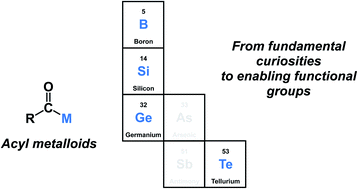Acyl metalloids: conformity and deviation from carbonyl reactivity
Abstract
Once considered as mere curiosities, acyl metalloids are now recognized for their utility in enabling chemical synthesis. This perspective considers the reactivity displayed by acylboron, -silicon, -germanium, and tellurium species. By highlighting the role of these species in various transformations, we demonstrate how differences between the comprising elements result in varied reaction outcomes. While acylboron compounds are primarily used in polar transformations, germanium and tellurium species have found utility as radical precursors. Applications of acylsilanes are comparatively more diverse, owing to the possibility to access both radical and polar chemistry.

- This article is part of the themed collection: Chemical Science Recent Perspective articles


 Please wait while we load your content...
Please wait while we load your content...